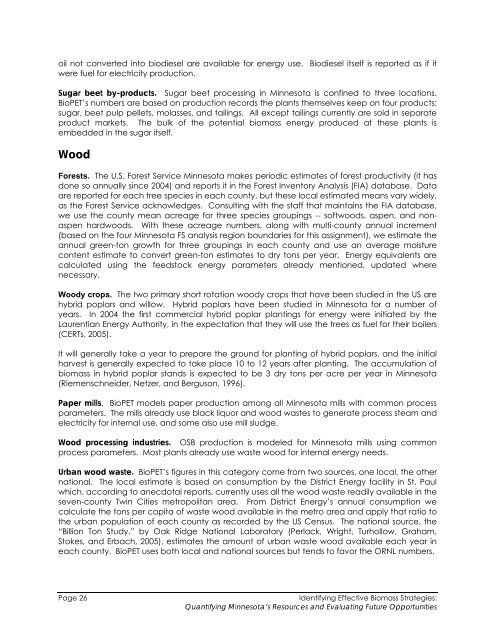Biomass Feasibility Project Final Report - Xcel Energy
Biomass Feasibility Project Final Report - Xcel Energy
Biomass Feasibility Project Final Report - Xcel Energy
You also want an ePaper? Increase the reach of your titles
YUMPU automatically turns print PDFs into web optimized ePapers that Google loves.
oil not converted into biodiesel are available for energy use. Biodiesel itself is reported as if it<br />
were fuel for electricity production.<br />
Sugar beet by-products. Sugar beet processing in Minnesota is confined to three locations.<br />
BioPET’s numbers are based on production records the plants themselves keep on four products:<br />
sugar, beet pulp pellets, molasses, and tailings. All except tailings currently are sold in separate<br />
product markets. The bulk of the potential biomass energy produced at these plants is<br />
embedded in the sugar itself.<br />
Wood<br />
Forests. The U.S. Forest Service Minnesota makes periodic estimates of forest productivity (it has<br />
done so annually since 2004) and reports it in the Forest Inventory Analysis (FIA) database. Data<br />
are reported for each tree species in each county, but these local estimated means vary widely,<br />
as the Forest Service acknowledges. Consulting with the staff that maintains the FIA database,<br />
we use the county mean acreage for three species groupings -- softwoods, aspen, and nonaspen<br />
hardwoods. With these acreage numbers, along with multi-county annual increment<br />
(based on the four Minnesota FS analysis region boundaries for this assignment), we estimate the<br />
annual green-ton growth for three groupings in each county and use an average moisture<br />
content estimate to convert green-ton estimates to dry tons per year. <strong>Energy</strong> equivalents are<br />
calculated using the feedstock energy parameters already mentioned, updated where<br />
necessary.<br />
Woody crops. The two primary short rotation woody crops that have been studied in the US are<br />
hybrid poplars and willow. Hybrid poplars have been studied in Minnesota for a number of<br />
years. In 2004 the first commercial hybrid poplar plantings for energy were initiated by the<br />
Laurentian <strong>Energy</strong> Authority, in the expectation that they will use the trees as fuel for their boilers<br />
(CERTs, 2005).<br />
It will generally take a year to prepare the ground for planting of hybrid poplars, and the initial<br />
harvest is generally expected to take place 10 to 12 years after planting. The accumulation of<br />
biomass in hybrid poplar stands is expected to be 3 dry tons per acre per year in Minnesota<br />
(Riemenschneider, Netzer, and Berguson, 1996).<br />
Paper mills. BioPET models paper production among all Minnesota mills with common process<br />
parameters. The mills already use black liquor and wood wastes to generate process steam and<br />
electricity for internal use, and some also use mill sludge.<br />
Wood processing industries. OSB production is modeled for Minnesota mills using common<br />
process parameters. Most plants already use waste wood for internal energy needs.<br />
Urban wood waste. BioPET’s figures in this category come from two sources, one local, the other<br />
national. The local estimate is based on consumption by the District <strong>Energy</strong> facility in St. Paul<br />
which, according to anecdotal reports, currently uses all the wood waste readily available in the<br />
seven-county Twin Cities metropolitan area. From District <strong>Energy</strong>’s annual consumption we<br />
calculate the tons per capita of waste wood available in the metro area and apply that ratio to<br />
the urban population of each county as recorded by the US Census. The national source, the<br />
“Billion Ton Study.” by Oak Ridge National Laboratory (Perlack, Wright, Turhollow, Graham,<br />
Stokes, and Erbach, 2005), estimates the amount of urban waste wood available each year in<br />
each county. BioPET uses both local and national sources but tends to favor the ORNL numbers.<br />
Page 26<br />
Identifying Effective <strong>Biomass</strong> Strategies:<br />
Quantifying Minnesota’s Resources and Evaluating Future Opportunities

















